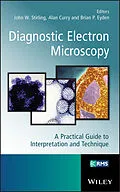Diagnostic Electron Microscopy Diagnostic Electron Microscopy: A Practical Guide to Interpretation and Technique summarises the current interpretational applications of TEM in diagnostic pathology. This concise and accessible volume provides a working guide to the main, or most useful, applications of the technique including practical topics of concern to laboratory scientists, brief guides to traditional tissue and microbiological preparation techniques, microwave processing, digital imaging and measurement uncertainty. The text features both a screening and interpretational guide for TEM diagnostic applications and current TEM diagnostic tissue preparation methods pertinent to all clinical electron microscope units worldwide. Containing high-quality representative images, this up-to-date text includes detailed information on the most important diagnostic applications of transmission electron microscopy as well as instructions for specific tissues and current basic preparative techniques. The book is relevant to trainee pathologists and practising pathologists who are expected to understand and evaluate/screen tissues by TEM. In addition, technical and scientific staff involved in tissue preparation and diagnostic tissue evaluation/screening by TEM will find this text useful.
Autorentext
John W. Stirling, The Centre for Ultrastructural Pathology, Adelaide, Australia
Alan Curry, Manchester Royal Infirmary, Manchester, UK
Brian P. Eyden, Christie NHS Foundation Trust, Manchester, UK
Klappentext
Diagnostic Electron Microscopy
Diagnostic Electron Microscopy: A Practical Guide to Interpretation and Technique summarises the current interpretational applications of TEM in diagnostic pathology. This concise and accessible volume provides a working guide to the main, or most useful, applications of the technique including practical topics of concern to laboratory scientists, brief guides to traditional tissue and microbiological preparation techniques, microwave processing, digital imaging and measurement uncertainty.
The text features both a screening and interpretational guide for TEM diagnostic applications and current TEM diagnostic tissue preparation methods pertinent to all clinical electron microscope units worldwide. Containing high-quality representative images, this up-to-date text includes detailed information on the most important diagnostic applications of transmission electron microscopy as well as instructions for specific tissues and current basic preparative techniques.
The book is relevant to trainee pathologists and practising pathologists who are expected to understand and evaluate/screen tissues by TEM. In addition, technical and scientific staff involved in tissue preparation and diagnostic tissue evaluation/screening by TEM will find this text useful.
Inhalt
List of Contributors xvii
Preface - Introduction xxi
1 Renal Disease 1 John W. Stirling and Alan Curry
1.1 The Role of Transmission Electron Microscopy (TEM) in Renal Diagnostics 1
1.2 Ultrastructural Evaluation and Interpretation 2
1.3 The Normal Glomerulus 3
1.3.1 The Glomerular Basement Membrane 4
1.4 Ultrastructural Diagnostic Features 5
1.4.1 Deposits: General Features 5
1.4.2 Granular and Amorphous Deposits 6
1.4.3 Organised Deposits: Fibrils and Tubules 7
1.4.4 Nonspecific Fibrils 11
1.4.5 General and Nonspecific Inclusions and Deposits 11
1.4.6 Fibrin 12
1.4.7 Tubuloreticular Bodies (Tubuloreticular Inclusions) 12
1.4.8 The Glomerular Basement Membrane 13
1.4.9 The Mesangial Matrix 14
1.4.10 Cellular Components of the Glomerulus 14
1.4.11 Parietal Epithelium 16
1.5 The Ultrastructural Pathology of the Major Glomerular Diseases 16
1.5.1 Diseases without, or with Only Minor, Structural GBM Changes 16
1.5.2 Diseases with Structural GBM Changes 19
1.5.3 Diseases with Granular Deposits 25
1.5.4 Diseases with Organised Deposits 40
1.5.5 Hereditary Metabolic Storage Disorders 46
References 47
2 Transplant Renal Biopsies 55 John Brealey
2.1 Introduction 55
2.2 The Transplant Renal Biopsy 55
2.3 Indications for Electron Microscopy of Transplant Kidney 56
2.3.1 Transplant Glomerulopathy 56
2.3.2 Recurrent Primary Disease 64
2.3.3 De Novo Glomerular Disease 72
2.3.4 Donor-Related Disease 74
2.3.5 Infection 74
2.3.6 Inconclusive Diagnosis by LM and/or IM 79
2.3.7 Miscellaneous Topics 81
References 84
3 Electron Microscopy in Skeletal Muscle Pathology 89 Elizabeth Curtis and Caroline Sewry
3.1 Introduction 89
3.1.1 The Biopsy Procedure 90
3.1.2 Sampling 90
3.1.3 Tissue Processing 90
3.1.4 Artefacts 91
3.2 Normal Muscle 91
3.3 Pathological Changes 96
3.3.1 Sarcolemma 96
3.3.2 Myofibrils 99
3.3.3 Glycogen 102
3.3.4 Cores 104
3.3.5 Target Fibres 105
3.3.6 Myonuclei 105
3.3.7 Mitochondria 106
3.3.8 Reticular System 108
3.3.9 Vacuoles 109
3.3.10 Capillaries 110
3.3.11 Other Structural Defects 111
References 113
4 The Diagnostic Electron Microscopy of Nerve 117 Rosalind King
4.1 Introduction 117
4.2 Tissue Processing 118
4.2.1 Preparation of Nerve Biopsy Specimens 118
4.3 Normal Nerve Ultrastructure 120
4.3.1 Axons 120
4.3.2 Schwann Cells 120
4.3.3 The Myelin Sheath 120
4.3.4 Node of Ranvier 122
4.3.5 Paranode 123
4.3.6 Juxtaparanode 123
4.3.7 Internode 123
4.3.8 Schmidt-Lanterman Incisures 124
4.3.9 Remak Fibres 124
4.3.10 Fibroblasts 124
4.3.11 Renaut Bodies 125
4.4 Pathological Ultrastructural Features 125
4.4.1 Axonal Degeneration 125
4.4.2 Axonal Regeneration 126
4.4.3 Remak Fibre Abnormalities 128
4.4.4 Polyglucosan Bodies 128
4.4.5 Nonspecific Axonal Inclusions 128
4.4.6 Demyelination and Remyelination 130
4.4.7 Specific Schwann Cell Inclusions 135
4.4.8 Nonspecific Schwann Cell Inclusions 136
4.4.9 Fibroblasts 142
4.4.10 Perineurial Abnormalities 142
4.4.11 Cellular Infiltration 143
4.4.12 Endoneurial Oedema 143
4.4.13 Connective Tissue Abnormalities 143
4.4.14 Endoneurial Blood Vessels 145
4.4.15 Mast Cells 145
4.5 Artefact 145
4.6 Conclusions 147
References 148
5 The Diagnostic Electron Microscopy of Tumours 153 Brian Eyden
5.1 Introduction 153
5.2 Principles and Procedures for Diagnosing Tumours by Electron Microscopy 154
5.2.1 The Objective of Tumour Diagnosis 154
5.2.2 The Intellectual Requirements for Tumour Diagnosis by Electron Microscopy 155
5.2.3 Technical Considerations 156
5.2.4 Identifying Good Preservation 158
5.2.5 Distinguishing Reactive from Neoplastic Cells 162
5.3 Organelles and Groups of Cell Structures Defining Cellular Differentiation 162
5.3.1 Rough Endoplasmic Reticulum 162
5.3.2 Melanosomes 165
5.3.3 Desmosomes 167
5.3.4 Tonofibrils 167
5.3.5 Basal Lamina 169
5.3.6 Glandular Epithelial Differentiation and Cell Processes 171
5.3.7 Neuroendocrine Granules 171
5.3.8 Smooth-Muscle Myofilaments 173
5.3.9 Sarcomeric Myofilaments (Thick-and-Thin Filaments with Z-Disks) 176
References 178
6 Microbial Ultrastructure 181 Alan Curry
6.1 Introduction 181
6.2 Practical Guidance 182
6.3 Viruses 183
6.4 Current Use of EM in Virology 185
6.5 Viruses in Thin Sections of Cells or Tissues 186
6.6 Bacteria 191
6.…
